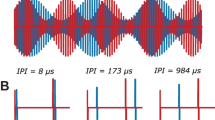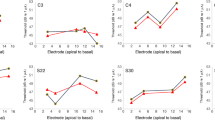Abstract
Temporal integration (TI; threshold versus stimulus duration) functions and multipulse integration (MPI; threshold versus pulse rate) functions were measured behaviorally in guinea pigs and humans with cochlear implants. Thresholds decreased with stimulus duration at a fixed pulse rate and with pulse rate at a fixed stimulus duration. The rates of threshold decrease (slopes) of the TI and MPI functions were not statistically different between the guinea pig and human subject groups. A characteristic of the integration functions that the two groups shared was that the slopes of the TI functions were similar in magnitude to slopes of the MPI function only at low pulse rates (< approximately 300 pulses per second). This is consistent with the notion that the TI functions and the MPI functions at the low rates are mediated by a mechanism of long-term integration described in the statistical “multiple looks” model. Histological analysis of the guinea pig cochleae suggested that the slopes of both the MPI and the TI functions were dependent on sensory and neural health near the stimulated regions. The strongest predictor for spiral ganglion cell densities measured near the stimulation sites was the slope of the MPI functions below 1,000 pps. Several mechanisms may be considered to account for the association of shallow integration functions with poor sensory and neural status. These mechanisms are related to abnormal across-fiber synchronization, increased refractoriness and adaptation with impaired neural function, and steep growth of neural excitation with current level associated with neural pathology. The slope of the integration functions can potentially be used as a non-invasive measure for identifying stimulation sites with poor neural health and selecting those sites for removal or rehabilitation, but these applications remain to be tested.





Similar content being viewed by others
References
Carlyon RP, Buus S, Florentine M (1990) Temporal integration of trains of tone pulses by normal and by cochlearly impaired listeners. J Acoust Soc Am 87:260–268
Carlyon RP, Wieringen AV, Deeks JM, Long CJ, Lyzenga J, Wouters J (2005) Effect of inter-phase gap on the sensitivity of cochlear implant users to electrical stimulation. Hear Res 205:210–224
Dolan FD, Alfred NL, Gopal A (1990) Asynchronous neural activity recorded from the round window. J Acoust Soc Am 87:2621–2627
Donaldson GS, Viemeister NF, Nelson DA (1997) Psychometric functions and temporal integration in electric hearing. J Acoust Soc Am 101:3706–3721
Eddington DK, Dobelle WH, Brackmann DE, Mladejovsky MG, Parkin JL (1978) Auditory prostheses research with multiple channel intracochlear stimulation in man. Ann Otol Rhinol Laryngol 87:1–39
Fayad JN, Linthicum FH Jr (2006) Multichannel cochlear implants: relation of histopathology to performance. Laryngoscope 116:1310–1320
Florentine M, Fastl H, Buus S (1988) Temporal integration in normal hearing, cochlear impairment, and impairment simulated by masking. J Acoust Soc Am 84:195–203
Garadat SN, Zwolan TA, Pfingst BE (2013) Using temporal modulation sensitivity to select stimulation sites for processor MAPs in cochlear implant listeners. Audiol Neurootol 184:247–260
Gerken GM, Bhat VK, Hutchison-Clutter M (1990) Auditory temporal integration and the power function model. J Acoust Soc Am 88:767–778
Green DM, Swets JA (1966) Signal detection theory and psychophysics. Wiley, New York
Green DM (1960) Auditory detection of a noise signal. J Acoust Soc Am 32:121–131
Hinojosa R, Marion M (1983) Histopathology of profound sensorineural deafness. Ann N Y Acad Sci 405:459–484
Kang SY, Colesa DJ, Swiderski DL, Su GL, Raphael Y, Pfingst BE (2010) Effects of hearing preservation on psychophysical responses to cochlear implant stimulation. J Assoc Res Otolaryngol 11:245–265
Kreft HA, Donaldson GS, Nelson DA (2004) Effects of pulse rate on threshold and dynamic range in Clarion cochlear-implant users. J Acoust Soc Am 115:1885–1888
Levitt H (1971) Transformed up-down methods in psychoacoustics. J Acoust Soc Am 49:467–477
Long CJ, Holden TA, McClelland GH, Parkinson WS, Shelton C et al (2014) Examining the electro-neural interface of cochlear implant users using psychophysics, CT scans, and speech understanding. J Assoc Res Otolaryngol 15:293–304
Matsuoka AJ, Abbas PJ, Rubinstein JT, Miller CA (2000) The neuronal response to electrical constant-amplitude pulse train stimulation: additive Gaussian noise. Hear Res 149:129–137
McKay CM, McDermott HJ (1998) Loudness perception with pulsatile electrical stimulation: the effect of interpulse intervals. J Acoust Soc Am 1042:1061–1074
McKay CM, Lim HH, Lenarz T (2013) Temporal processing in the auditory system: insights from cochlear and auditory midbrain implantees. J Assoc Res Otolaryngol 14:103–124
Middlebrooks JC (2004) Effects of cochlear-implant pulse rate and inter-channel timing on channel interactions and thresholds. J Acoust Soc Am 116:452–468
Moore BC, Glasberg BR, Plack CJ, Biswas AK (1988) The shape of the ear’s temporal window. J Acoust Soc Am 83:1102–1116
Moxon ED (1971) Neural and mechanical responses to electric stimulation of the cat’s inner ear. MIT-Doctoral Dissertation, Cambridge
Nadol JB Jr, Shiao JY, Burgess BJ, Ketten DR, Eddington DK, Gantz BJ, Kos I, Montandon P, Coker NJ, Roland JT Jr, Shallop JK (2001) Histopathology of cochlear implants in humans. Ann Otol Rhinol Laryngol 110:883–891
Oxenham AJ, Moore BC (1994) Modeling the additivity of nonsimultaneous masking. Hear Res 80:105–118
Penner MJ (1978) A power law transformation resulting in a class of short-term integrators that produce time-intensity trades for noise bursts. J Acoust Soc Am 63:195–201
Prado-Guitierrez P, Fewster LM, Heasman JM, McKay CM, Shepherd RK (2006) Effect of interphase gap and pulse duration on electrically evoked potentials is correlated with auditory nerve survival. Hear Res 215:47–55
Pfingst BE, Colesa DJ, Hembrador S, Kang SY, Middlebrooks JC, Raphael Y, Su GL (2011) Detection of pulse trains in the electrically stimulated cochlea: effects of cochlear health. J Acoust Soc Am 130:3954–3968
Pfingst BE, DeHaan DR, Holloway LA (1991) Stimulus features affecting psychophysical detection thresholds for electrical stimulation of the cochlea. I: phase duration and stimulus duration. J Acoust Soc Am 90:1857–1866
Pfingst BE, Morris DJ (1993) Stimulus features affecting psychophysical detection thresholds for electrical stimulation of the cochlea. II: frequency and interpulse interval. J Acoust Soc Am 94:1287–1294
Plomp R, Bouman MA (1959) Relation between hearing threshold and duration for tone pulses. J Acoust Soc Am 31:749–758
Ramekers D, Versnel H, Strahl SB, Smeets EM, Klis SF et al (2014) Auditory-nerve responses to varied inter-phase gap and phase duration of the electric pulse stimulus as predictors for neuronal degeneration. J Assoc Res Otolaryngol 15:187–202
Searchfield GD, Munoz DJB, Thorne PR (2004) Ensemble spontaneous activity in the guinea-pig cochlear nerve. Hear Res 192:23–35
Shannon RV (1985) Threshold and loudness functions for pulsatile stimulation of cochlear implants. Hear Res 18:135–143
Shannon RV (1989) A model of threshold for pulsatile electrical stimulation of cochlear implants. Hear Res 40:197–204
Shannon RV (1993) Psychophysics in cochlear implants. Audiological foundations edited by Tyler RS. Singular, San Diego, pp 357–388
van den Honert C, Stypulkowski PH (1984) Physiological properties of the electrically stimulated auditory nerve. II. single fiber recordings. Hear Res 14:225–243
Viemeister NF (1979) Temporal modulation transfer functions based upon modulation thresholds. J Acoust Soc Am 66:1364–1380
Viemeister NF, Wakefield GH (1991) Temporal integration and multiple looks. J Acoust Soc Am 90:858–865
Wilson BS, Finley CC, Lawson DT, Zerbi M (1997) Temporal representations with cochlear implants. Am J Otol 18:S30–S34
Zhou N, Pfingst BE (2012) Psychophysically based site selection coupled with dichotic stimulation improves speech recognition in noise with bilateral cochlear implants. J Acoust Soc Am 132:994–1008
Zhou N, Pfingst BE (2014a) Effects of site-specific level adjustments on speech recognition with cochlear implants. Ear Hear 35:30–40
Zhou N, Pfingst BE (2014b) Relationship between a psychophysical estimate of neural health and speech recognition with cochlear implants. J Acoust Soc Am 136:1257–1268
Zhou N, Xu L, Pfingst BE (2012) Characteristics of detection thresholds and maximum comfortable loudness levels as a function of pulse rate in human cochlear implant users. Hear Res 284:25–32
Zhou R, Assouline JG, Abbas PJ, Messing A, Gantz BJ (1995a) Anatomical and physiological measures of auditory system in mice with peripheral myelin deficiency. Hear Res 88:87–97
Zhou R, Abbas PJ, Assoulin JG (1995b) Electrically evoked auditory brainstem response in peripherally myelin-deficient mice. Hear Res 88:98–106
Acknowledgments
We thank our dedicated subjects with cochlear implants. The research was supported by NIH-NIDCD R01 DC010786, R01 DC 007634, R01 DC010412, T32 DC00011, P30 DC05188, the U. of M. Center for Organogenesis, and a contract from MED-El. We thank Jennifer M. Benson, Lisa L. Kabara, and Melissa M. Watts for their assistance with data collection and the laboratory of Dr. Yehoash Raphael for contributions to the gene therapy and histological work in guinea pigs.
Conflict of Interest
The authors declare that they have no conflict of interest.
Author information
Authors and Affiliations
Corresponding author
Rights and permissions
About this article
Cite this article
Zhou, N., Kraft, C.T., Colesa, D.J. et al. Integration of Pulse Trains in Humans and Guinea Pigs with Cochlear Implants. JARO 16, 523–534 (2015). https://doi.org/10.1007/s10162-015-0521-0
Received:
Accepted:
Published:
Issue Date:
DOI: https://doi.org/10.1007/s10162-015-0521-0




